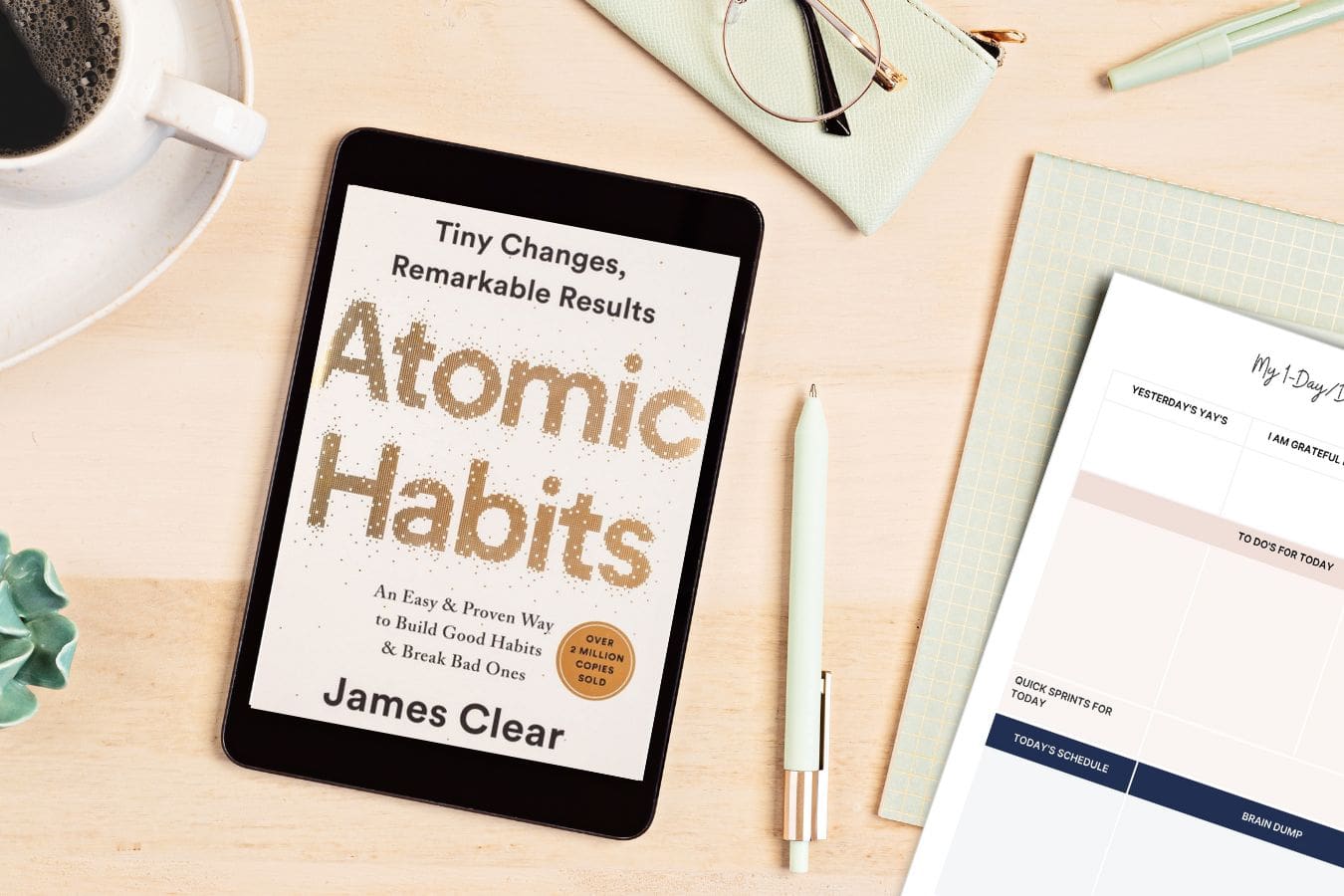Earlier this week, my husband shared notes from “Atomic Habits”, a book he read back in 2021. Hearing what he had to say and knowing that a lot of people with ADHD rave about it, I decided to give it a go.
To be perfectly honest, I still haven’t read the whole thing – I already got excited at the “Four Laws of Behavior Change” and had to write this post.
The ‘Four Laws of Behavior Change’ are the principles the author deems essential for forming and maintaining new habits. If you need a refresher or aren’t familiar, here are the four laws:
- Make it obvious. This involves setting clear intentions and designing your environment in a way that supports your desired habit. It’s about making the cues that trigger your habits obvious and noticeable.
- Make it attractive. The more appealing and enticing the habit is, the more likely you’ll be to follow through with it. This can be done by pairing a habit you need to do with a habit you want to do.
- Make it easy. Habits that require less effort are more likely to stick. Reduce the number of steps to perform the habit, or optimize your environment in a way that makes the desired behavior easier to start.
- Make it satisfying. You’re more likely to repeat a habit if the experience is satisfying. This means giving yourself an immediate reward when you complete the habit or tracking your progress to provide positive feedback.
The reason I got so excited is because I see strong parallels between these laws and the Mindflows philosophy. For those of you who are fans, I wanted to break it down so that if you’re looking to integrate these philosophies you can see how the Mindflows Planning Bundle can help.
Let’s begin with the first law.
1. Make It Obvious:
I’ll admit, I’ve tried some pretty quirky stuff to keep planning in my face. I’ve done things like scribbling to-dos on my desk glass or placing my notebook on my keyboard at the end of every day. However, it turns out a clutter-free desk is crucial for me, and I kept forgetting to put my planner on my keyboard, so that method didn’t pan out.
But I have found a more obvious (and simpler) way!
These days, I’ve gone high-tech by setting my 90-day or Big Picture Planner as my computer wallpaper. And to top it off, I’ve got this flashy, laminated planner cover that’s impossible to ignore. It’s like my personal cheerleader, and it’s all in line with James’ 2nd law.
2. Make It Attractive
In the past, I often bought beautiful planners that, ironically, I never used. Why? I was terrified of ruining their perfection. But let’s be honest, ordinary binders or heaps of jotted-down notes weren’t cutting it for me.
So, I took an artistic turn, designing ornate to-do lists on glass frames. While they initially seemed appealing, they quickly turned into an illegible mess.
Now, I have a vibrant laminated planner cover. It’s not just aesthetically pleasing but also keeps my anxiety in check. Inside the planner, there’s a section titled “Things That Are Making Me Happy”—a delightful start to any day! I’m maintaining a balance and not drowning in minutiae, in alignment with James’ 3rd law.
3. Make It Easy:
Let’s face it—planning shouldn’t feel like deciphering a cryptic code. I once made intricate planning cues on frames, which felt interpreting hieroglyphics. That wasn’t ideal.
So, I shifted to printables on standard letter-sized paper. This option is accessible, budget-friendly, and offers room for personalization.
I’ve started using this discbound system, and let me tell you—it’s been amazing. Sure, it took a little time to set up at first, but now? It’s so simple and neat. I love how easily I can add or remove pages. It’s been a big help in keeping things organized.
4. Make It Satisfying:
You know that feeling when things get too “the same”? I’ve been there. To keep planning fresh and fun, I jazzed up my planners with calming colors, a tidy layout, and nice, readable fonts. A planner’s got to look good, but it shouldn’t overwhelm me with too much flash.
Oh, and that gratitude section and flashy laminated cover I mentioned? I added some super smooth, thick paper for the planner pages. Trust me, it feels so luxurious! Regular paper? It’s okay, but not quite the same.
All these tweaks? They make planning feel special. And don’t get me started on changing up pen colors—it makes planning feel like a special treat!
Summary
To sum it up, here’s how the “Four Laws of Behavior Change” from “Atomic Habits” apply to the Mindflows planning bundle.
- I’ve made planning hard to miss, using both digital and real-world reminders.
- I’ve made it look cool and appealing with fancy aesthetics.
- I’ve simplified things by using printouts and a handy discbound system.
- I’ve made it more enjoyable by focusing on gratitude, quality paper, and fun, colorful pens.
I hope these tricks help you step up a planning system that works for you too!


